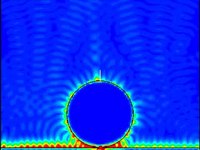
Photo from wikipedia
Continuous fiber-reinforced composites are important materials that have the highest commercialized potential in the upcoming future among existing advanced materials. Despite their wide use and value, their theoretical mechanisms have… Click to show full abstract
Continuous fiber-reinforced composites are important materials that have the highest commercialized potential in the upcoming future among existing advanced materials. Despite their wide use and value, their theoretical mechanisms have not been fully established due to the complexity of the compositions and their unrevealed failure mechanisms. This study proposes an effective three-dimensional damage modeling of a fibrous composite by combining analytical micromechanics and evolutionary computation. The interface characteristics, debonding damage, and micro-cracks are considered to be the most influential factors on the toughness and failure behaviors of composites, and a constitutive equation considering these factors was explicitly derived in accordance with the micromechanics-based ensemble volume averaged method. The optimal set of various model parameters in the analytical model were found using modified evolutionary computation that considers human-induced error. The effectiveness of the proposed formulation was validated by comparing a series of numerical simulations with experimental data from available studies.
Journal Title: Computational Mechanics
Year Published: 2017
Link to full text (if available)
Share on Social Media: Sign Up to like & get
recommendations!